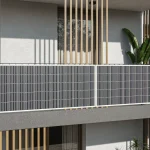Solar panels are gradually becoming a popular way to sustainably power homes and reduce dependence on the grid. While the initial costs of switching to solar energy can be quite high, there are various ways to help cover the purchase and installation expenses of the panels. The best solar panel loans typically offer competitive interest rates, low fees, no down payments, and flexible repayment terms.
Many residents in the US are concerned about the continuous rise in electricity bills, leading them to turn to solar panels as an environmentally friendly and cost-effective solution. However, the initial investment in a solar system usually ranges from $15,000 to $23,000, depending on the number of panels required and the household’s energy needs. This is where solar panel loans become particularly important, as they provide financial support to individuals and families, allowing them to transition to solar energy without having to pay large upfront costs.
In the US, there are various solar panel loan options available, each tailored to different financial situations. If you prefer not to use a loan to cover the cost of solar panels and are seeking a more cost-effective alternative, you may consider Sungold’s monocrystalline foldable solar panels, which offer a more flexible and convenient option.
Table of Contents
What is the cost of a solar panel?
The installation cost of solar panels ranges from $3,500 to $35,000, with an average cost of approximately $16,000. The exact installation cost depends on the size of the system and its location, typically falling between $15,000 and $25,000.
Although the initial cost of converting a home to solar power is high, state and federal incentives can significantly help eligible homeowners reduce their expenses. For example, state tax credits can cover 10% to 20% of the installation cost, while homeowners may also qualify for a 22% to 26% federal tax credit, depending on when the installation takes place. When calculating the actual cost of solar panels, these incentives should be deducted from the total system price.
Due to the substantial upfront costs, many homeowners choose to take out loans to cover installation expenses. As you will discover, there are various solar panel loan options available in the US, each designed to cater to different financial needs and individual circumstances. If you prefer not to opt for a loan and are looking for a more cost-effective alternative, you might consider Sungold’s monocrystalline foldable solar panels, which offer a more flexible option.
How to Compare Solar Panel Loans
Follow these tips when comparing solar panel loans:
Consider solar-specific loan products
Look for loans designed specifically for solar panels, such as financing options offered by solar panel manufacturers or installers. These loans often come with more competitive terms.
Shop around for the best deal
Take the time to compare different loan products, focusing on interest rates, repayment terms, and associated fees. By comparing multiple options, you can find the one that best suits your budget and needs.
Carefully review loan terms
Before signing any loan agreement, make sure to read the details thoroughly, ensuring you fully understand all terms and conditions, especially those related to leasing and Power Purchase Agreements (PPA).
Clarify your solar goals
Before committing to a loan or lease agreement, reflect on your reasons and objectives for installing a solar system, and ensure your financing plan aligns with these goals.
Understand tax incentives
Research and take full advantage of the tax incentives offered by your state and the federal government to reduce the overall cost of your solar system.
What Are Solar Loans and How Do They Work?
As the name suggests, solar loans are a form of financing that help homeowners or business owners install solar panels on their properties with little to no upfront cost. They operate similarly to traditional home improvement loans and are provided by banks or private financial institutions to cover the purchase and installation costs of solar systems.
Like other types of loans, borrowers are required to repay the loan in monthly instalments over an agreed period. This allows them not only to reduce their electricity bills but also to benefit from federal or local government tax incentives or subsidies, further lowering the installation costs.
The operation of solar panel loans is as follows:
Before selecting a solar loan, it is essential to compare the interest rates and customer reviews of different loan providers to ensure you receive the most favourable terms. Once you’ve identified a suitable solar loan provider, you can sign the loan agreement and make an initial payment (if required). After the homeowner opts for a solar loan, the lender will pay the installation costs directly to the solar installer, and you will simply repay the lender monthly.
Solar loans generally offer lower interest rates, making them a more attractive option compared to other financing methods. The repayment period usually ranges from 5 to 20 years, allowing you to choose a term that best suits your needs. If you plan to use solar energy in 2024, it is recommended to consider Sungold’s foldable portable solar panels, which are convenient and easy to use, converting solar energy into electricity to charge your home or outdoor equipment.
In the US, the cost of installing solar panels is influenced by various factors, including the manufacturer, the type of solar panel, the service provider, and the amount of electricity used monthly or annually. For instance, monocrystalline solar panels are priced around $1 to $1.50 per watt, while polycrystalline panels cost approximately $0.90 to $1 per watt. However, with advancements in technology, the use of polycrystalline solar panels is gradually declining, with more users opting for the higher-performing monocrystalline modules.
How to Obtain a Solar Panel Loan
Borrowers typically need a credit score of at least 680 to qualify for a solar loan. However, some lenders have more flexible requirements, allowing a minimum credit score of 550 or 580. In addition, lenders may require home equity or other loan eligibility criteria.
If you’re ready to apply for a solar panel loan, consider the following financing options:
Inquire About In-House Financing Depending on your location and the type of panels you purchase, there are various ways to finance solar panels. Start by asking solar panel manufacturers and installers whether they offer in-house financing. This can be a good option if your credit history is less than ideal or if you wish to simplify the loan process.
Seek Recommendations Ask manufacturers if they have partnerships with financial institutions that provide solar loans. If friends or family have already installed solar systems, their experiences and recommendations may also prove helpful.
Contact Local Banks Many traditional lenders, such as banks and credit unions, offer solar loans. If you have an established relationship with these institutions, they might offer you more favourable interest rates.
Online Loan Providers Currently, many online lending platforms offer loans specifically for solar systems, or you can use a personal loan to purchase and install a home solar system.
Analysis of Solar Panel Installation Costs in the United States
In the United States, the cost of installing solar panels is influenced by various factors, including the manufacturer, type of solar panel, service provider, regional characteristics, and individual energy requirements. Below are some common types of solar panels and their associated costs:
- Monocrystalline Solar Panels: Costing approximately $1 to $1.50 per watt, these panels are renowned for their high efficiency.
- Polycrystalline Solar Panels: With a cost of around $0.90 to $1 per watt, these panels, although cheaper, are gradually being phased out due to their lower efficiency.
As solar technology advances, more people are opting for the more efficient monocrystalline panels rather than polycrystalline ones.
How Solar Panel Tax Credits Work
Tax credits directly reduce the amount of tax you owe for that year. If you install a solar photovoltaic system between 2022 and 2032, you are eligible for a federal tax credit equal to 30% of the installation cost, calculated after utility rebates but before state rebates.
For example, if you pay $24,000 for the system in 2023, you can reduce your 2023 tax bill by $7,200. If you only owe $5,000 in taxes that year, the remaining $2,200 credit can be carried forward to 2024. Additionally, your state or city may offer further tax benefits, such as sales tax exemptions. Utility companies or local governments may also provide rebates or grants, further reducing your costs.
Frequently Asked Questions (FAQs)
What is the interest rate for solar loans?
Solar panel loans typically have an interest rate between about 4% and 17% (up to 36% for personal loans). That said, the interest rate a borrower qualifies for will depend on their credit score, the loan term length and the size of the solar panel system.
The typical term for a solar loan is how long?
The term for unsecured personal loans ranges from 1 to 7 years, while secured solar panel loans typically have terms of 10 to 20 years. Some specialised lenders offer more flexible options, with terms extending up to 25 or 30 years. The length of the term ultimately depends on various factors, including the size and cost of the solar panel system, the interest rate, and the borrower’s creditworthiness.
Is a solar loan worth it?
To determine whether a solar loan is financially worthwhile, calculate the actual cost of the solar panels by subtracting any available rebates and tax credits from the total system cost. Then, estimate how much you can save on electricity bills each year by switching to solar. Divide the actual cost of the system by the annual savings to calculate how many years it will take to pay off the cost of the solar panels.
If you plan to stay in the property beyond the breakeven point, switching to solar could be worth it. However, keep in mind that this calculation is very basic and doesn’t take into account interest costs or intangible factors, such as the value of going off-grid or your desire to be more sustainable.







